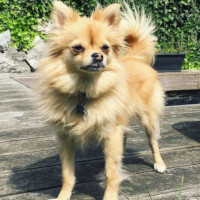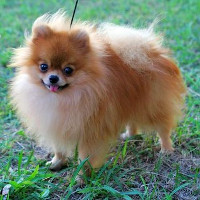Appearance of the Pomchi
|
| Pomchis have an alert, intelligent expression. They owe their fox-like appearance to their Pomeranian parent, and may or may not have a double coat, depending on the Pomeranian's contribution. If they have an undercoat, it is soft and very thick. Their coat can be short or long, and of different colors: light brown (most common), dark brown, cream, fawn, white, bronze, gray, sable, black (less common). Pomchis have round heads, with larger-than-average round eyes and pointed furry ears. They have a muscular hindquarters like the Chihuahua, with short, strong legs. Pomchis generally weigh no more than 3 kg and measure up to 25 cm. |
Temperament of the Pomchi
|
| Pomchis are generally said to have a big personality in a little bundle of fur. They're lively, curious and alert. Pomchis are energetic and fun-loving, very friendly and people-oriented. They make excellent pets, indeed. However, they also tend to be quite nervous and anxious, which can degenerate into aggression, as they are bold and fearless. This trait should be avoided through appropriate early socialization and training. Pomchis are brilliant if well behaved, approachable and loving. They are undoubtedly loyal to their owners and can make excellent watchdogs, as they are vocal and energetic. Pomchis can suffer from separation anxiety and should therefore not be left alone for long periods. Because they are small and fragile, they should not be left unsupervised with younger children who have not learned to handle and interact with dogs carefully and responsibly. Not only is this dangerous for the animal, but it can also be a risk for the child, as if the dog gets too worked up, it could react more aggressively. They are therefore best suited to families with older children, or no children at all. |
Needs and activities of the Pomchi
|
| The Pomchi is a fairly active dog, and although it will do most of its exercise at home, it will still need a daily walk. They should be trained and socialized from 12 weeks of age to ensure they become well-balanced dogs. Walks and play in dog parks are ways of ensuring they get used to meeting other dogs and people. Pomchi love to play games and will respond well to challenging tasks that exercise their inquisitive nature. Is are ideal for apartment living or a house with a yard will provide them with space to explore. These active little dogs learn quickly and respond best to good but firm teaching, and as long as it's fun, they'll want to please. |
Maintenance of the Pomchi
|
| The Pomchi has a long or dense coat and is a medium shedder, so a beautiful coat will require daily brushing to avoid tangling. Your pet may need to consult a professional groomer to have it trimmed and kept in good condition. This should only be done every two or three months. Grooming is an ideal time to check your dog for cuts or abrasions, and to check his ears for inflammation, to avoid inflammation caused by dust or foreign bodies such as seeds. Gently wipe the ears with a damp cloth, taking care to avoid the delicate inner ear. Using a mild dog shampoo when bathing your dog will help prevent any allergic reaction and preserve the skin's natural protective oils. Train your dog to brush his teeth, as these small dogs are prone to teething problems. Start with small sessions to get them used to it, and build up from there. Making it fun with lots of praise and attention will make it easier for you. Finally, all that's left to do is clip their nails and they're ready to go. |









 English (United Kingdom)
English (United Kingdom)